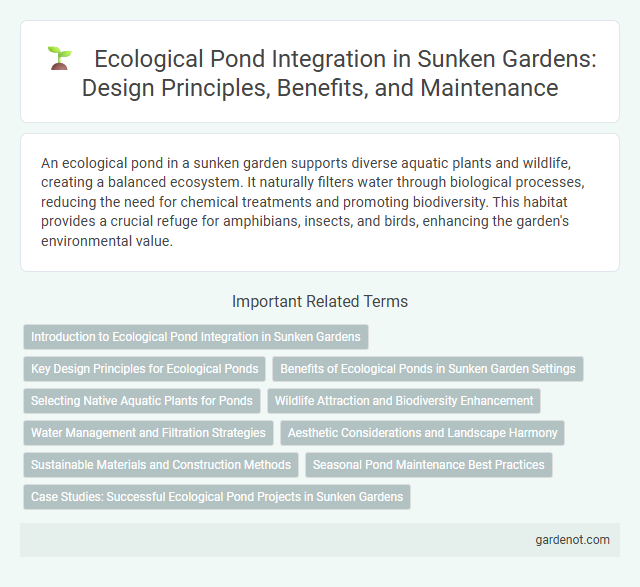An ecological pond in a sunken garden supports diverse aquatic plants and wildlife, creating a balanced ecosystem. It naturally filters water through biological processes, reducing the need for chemical treatments and promoting biodiversity. This habitat provides a crucial refuge for amphibians, insects, and birds, enhancing the garden's environmental value.
Introduction to Ecological Pond Integration in Sunken Gardens
Ecological ponds in sunken gardens serve as sustainable water features that support biodiversity by providing habitats for aquatic plants, insects, and amphibians. These ponds utilize natural filtration through plants and microorganisms, enhancing water quality without chemical treatment. Integrating ecological ponds into sunken gardens promotes natural ecosystem balance while creating visually appealing and educational green spaces.
Key Design Principles for Ecological Ponds
Ecological ponds prioritize biodiversity by incorporating native plant species and natural filtration systems that promote water quality and habitat diversity. Key design principles include ensuring varied pond depths to support different aquatic life, creating gentle sloping banks to facilitate wildlife access, and integrating sediment control measures to prevent nutrient overload. Properly designed ecological ponds balance aesthetic appeal with sustainable ecosystem functions, supporting flora and fauna resilience.
Benefits of Ecological Ponds in Sunken Garden Settings
Ecological ponds in sunken garden settings enhance biodiversity by creating habitats for amphibians, insects, and aquatic plants that thrive in natural water cycles. These ponds improve water quality through natural filtration processes, reducing runoff pollution and promoting groundwater recharge. Integrating ecological ponds supports sustainable garden management by minimizing the need for chemical fertilizers and pesticides, fostering a balanced ecosystem.
Selecting Native Aquatic Plants for Ponds
Selecting native aquatic plants for ecological ponds enhances biodiversity, supports local wildlife, and maintains water quality naturally. Species such as pickerelweed, water lilies, and cattails are well-adapted to local climates and help stabilize pond ecosystems by providing oxygen and habitat. Incorporating these native plants minimizes maintenance needs and promotes a balanced, sustainable aquatic environment.
Wildlife Attraction and Biodiversity Enhancement
Ecological ponds in sunken gardens serve as vital habitats, attracting diverse wildlife such as amphibians, insects, and birds, thereby enhancing local biodiversity. The presence of native aquatic plants and clean water supports a balanced ecosystem, promoting natural behaviors and breeding grounds for various species. These ponds contribute to ecological stability by improving water filtration, providing food sources, and creating microhabitats that sustain a range of flora and fauna.
Water Management and Filtration Strategies
Ecological ponds in sunken gardens utilize advanced water management techniques to maintain optimal water quality and support biodiversity. Filtration strategies include natural biofilters such as aquatic plants and microbial communities that break down pollutants and enhance oxygen levels. Efficient water circulation systems minimize stagnation, promoting a balanced ecosystem and reducing algae growth.
Aesthetic Considerations and Landscape Harmony
An ecological pond within a sunken garden enhances aesthetic appeal by integrating native aquatic plants and natural water features that create a tranquil visual focal point. The design promotes landscape harmony by blending seamlessly with surrounding vegetation, promoting biodiversity while maintaining balanced proportions and naturalistic textures. Incorporating elements like submerged stones and gentle water flow supports both wildlife habitats and an overall serene, cohesive environment.
Sustainable Materials and Construction Methods
The ecological pond in the Sunken Garden is constructed using sustainable materials such as locally sourced natural stone and recycled timber, minimizing environmental impact. Innovative construction methods include biofiltration systems and permeable linings that support water purification and habitat creation. These eco-friendly techniques promote biodiversity while ensuring long-term durability and reduced maintenance.
Seasonal Pond Maintenance Best Practices
Seasonal pond maintenance in ecological sunken gardens involves regular debris removal and careful monitoring of water quality to support native aquatic plants and wildlife. Managing nutrient levels through controlled fertilization and avoiding chemical treatments helps prevent algal blooms and maintains balanced ecosystems. Proper aeration and sediment control techniques ensure oxygenation and clarity, promoting healthy biodiversity throughout seasonal changes.
Case Studies: Successful Ecological Pond Projects in Sunken Gardens
Ecological ponds in sunken gardens serve as vital biodiversity hotspots, supporting native aquatic plants and wildlife while naturally purifying water through biofiltration processes. Case studies from Singapore Botanic Gardens and the Butchart Gardens in Canada highlight successful integration of ecological ponds that enhance aesthetic value and promote sustainable water management in sunken garden designs. These projects demonstrate improved habitat creation, reduced chemical use, and increased public engagement in conservation efforts.
Ecological pond Infographic

 gardenot.com
gardenot.com